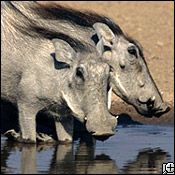Wartlike growths up to six inches (15 cm) long on the eyes and under the jaws are responsible for the name of this species. These protuberances are thought to protect against injuries that might otherwise occur when desert warthogs fight.
Small family groups of six to eighteen females plus their offspring are common.
Advertisement
The males are usually solitary, but may form bachelor groups. Occasionally several small groups come together to form a clan.
Diurnal vegetarians, they feed on grasses and seeds, as well as roots, tubers, and bulbs.
They allow birds called oxpeckers to alight on their back and pick off parasites. Wallowing in mud also helps get rid of the parasites while simultaneously providing relief from the heat of the day.
Advertisement
